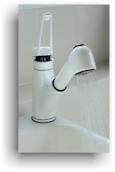

You may wonder why an energy library is discussing water use. Certainly within your own facility it costs money to heat the water. But the water company also spends a lot of money on energy to pump and purify the water it delivers to you. So a portion of your water bill is actually an energy bill. The same logic holds true for sewage treatment. If you have a business such as a restaurant, bakery, food-processing plant, hotel, nursing home, or laundry and your business uses large amounts of water, you will benefit even more from water use optimization.
 |
Like everything else, savings from water measures can vary. You can save
on the cost of the water, you can save on sewage, and you can also save on energy costs
for pumping or heating processes. Because savings come from so many sources, water
reduction upgrades are frequently profitable. Efficient showerheads and faucet aerators are inexpensive devices (they generally cost between $2 and $20) that screw into existing pipe fittings to help reduce water consumption. These devices reduce the amount of water used in common daily tasks. If your business is a hotel, motel, or restaurant, you can use these devices to significantly reduce your water-heating bills as well as your water bills. |
By repairing a seal that leaks a drop of electrically heated hot water every five seconds, you can save about 400 gallons of water, 85 kilowatt-hours (kWhs) of electricity, 125 pounds of carbon dioxide, and $10 per year.
Automatic controls such as valves or springs with sensors that turn faucets off can also help save water. The spring-loaded valves will automatically turn the water off when the user releases the handle. Photocell-equipped sensors are gaining popularity in controlling water use in restrooms. Almost all major airports have installed them due to their high intensity of use and because luggage and other articles tend to tie up travelers’ hands. These sensors detect motion and shut the water off after the user leaves.
The amount of water used when flushing toilets can be drastically reduced without compromising efficacy by using new-design, low-volume toilet fittings. These fittings can reduce the amount of water used per flush by about 66 percent by using improved water flow characteristics. High-quality, pressurized, low-volume toilets tend to cost about $200 more than gravity toilets, but they are worth the premium if the toilets will be flushed more than 20 times per day.
New washing machines with a horizontal axis design use much less water than the older types of washing machines. The new machines can help save water as well as reduce water heating costs for laundries, hotels, and nursing homes. They can also reduce the amount of detergent that is used for washing the same amount of clothes. The newer design machines occupy less space and do not produce as much heat as the older design washing machines, which use much more hot water; thus, your rent and air-conditioning requirements can also be reduced. New machines also remove more water from the laundry during the spin cycle, thereby greatly reducing drying time and energy use.
Source: U.S. EPA, Putting Energy Into Profits, ENERGY STARŪ Small Business Guide
|
|

|
| Copyright Aclara Technologies LLC. All Rights Reserved. | |